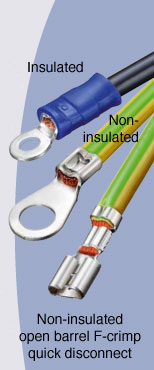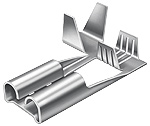VW Baywindow Bus - Wiring Harness Terminals
by Richard Atwell
(c) Copyright 2005-2011

VW Baywindow Bus - Wiring Harness Terminalsby Richard Atwell |

|

Anyone repairing vintage German wiring harnesses knows the only way to do it right is to use the original factory style terminals. Old terminals cause brake lights to turn on/off intermittently and vibration can work them loose if they have been handled many times over the years (e.g. coil wires).
Although you can clean the terminals with a de-oxidizing solution to remove some of the corrosion that occurs from 25 years of age, you will often find that after removing old terminals a few times, they do not hold on very well. This is because the corrosion has caused them to lose some of their flex. Sometimes the flexible part of the terminal simply snaps off when you attempt to adjust them with pliers.
Upon closer inspection, you will find that while the terminals have corroded the conductor inside the wire jacket will contain shiny copper even after 25 years. Fortunately VW provided enough slack in the harnesses to allow you to cut off the old terminal to expose some "fresh" conductor and crimp on a new terminal. I've replaced all of the terminals in my engine compartment and the conductivity is almost like new again (good for another 25+ trouble free years I figure).
What makes these non-insulated terminals special is that they hold on well, make great contact with the conductor and provide strain relief by crimping the insulation. The crimp on the insulation also serves to keep contaminants out.
However, they are non-insulated so covering them with shrink tubing or plastic connectors where appropriate to prevent electrical shorts is a good idea in the same locations that the factory did. Looking behind the dash and seeing all those "bare" connections can scare the hell out of people who aren't expecting to see that having worked on more modern vehicles.


AMP says it best:
Experience over widespread segments of industry has proved this crimp to be the most effective way of assuring stable electrical and mechanical performance. Applied with matching tooling, the F-crimp offers precise tensile strength and conductivity that will last the life of the circuit. This method of termination also assures maximum resistance to vibration and corrosion.
These terminals are often referred to using a variety of names:
This can make finding the correct tool difficult with so many crimpers out there and more so considering that some crimpers can be equipped with 15+ different interchangeable crimping dies.
Why F-crimp? I can only assume because it's the shape of the terminal before crimping when held from the side.

The correct hand tool for the job is one that can crimp these terminals (quick disconnect open barrel non-insulated f-crimp) in one step (often with a ratcheting mechanism). The VW tool is NLA from Volkswagen and very hard to find (see P/N in photo):
An equally good, more available and affordable substitute exists from Del City for $28.
Simply finding a crimper that states it crimps non insulated terminals will NOT be sufficient. It must also state open barrel and have the f-crimp style nests in the jaws (click on photo for closeup). Few companies state f-crimp in their literature.
If you've got big money ($200-300) to spend you'll find the best ergonomic crimpers available are made in Germany and come from AMP/Tyco, Molex and T&B. T&B makes a really nice crimper that I'm sure is the crimper of choice for field technicians. When volume production is called for, an expensive bench mounted crimper is required to prevents repetitive strain injury and carpal tunnel syndrome. I believe Facom rebrands The T&B crimper.

Several companies (e.g. Paladin, Sargent and Ideal) make crimpers but finding one with a suitable die is difficult because they are usually designed for telephone/coax/computer only or can only crimp one size of terminal.
There are two commonly found crimpers that are useful to know about for other tasks if only to recognize them and realize they do not crimp our terminals:
Tool Aid sells something similar in a kit with several dies for crimping insulated and other terminals but none of their dies are designed for our terminals. I almost bought one by mistake but a call to Tool Aid confirmed they didn't have what I was looking for. A die to crimp our terminals is the number one request but they do not wish to supply it for unknown reasons.
It's still a very useful tool so I'll list what it can do:
Tool Aid #18900 crimps 10-22 gauge insulated terminal without interchangeable dies. Get this if you have an American car but no VWs.
Tool Aid #18920 is their complete kit w/ 5 dies including:
Tool Aid #18930 is a red handled crimper comes with the #18922 die set for crimping Weatherpack terminals. Although it looks like it can be used for our terminals they are not exactly the same. The manufacturer says the crimps are different but I know people are using this tool anyway.
Tool Aid has their tool made for them in China and several other companies sell this model with a variety of dies for various connectors. Search eBay for "crimper" and make sure the tool you find crimps the right type of terminals (don't expect the seller to know especially if the price is low). Also be careful of dies that won't fit your crimper because several styles exist.
Recently, MSD started to offer their PRO-CRIMP TOOL II 35051 which replaces their older 3505 model but may use the same dies. In some photos, the 35051 looks and sounds like it could be made by AMP and in others the 3505 looks like the Tool Aid crimper. It's more expensive than the Tool Aid version. Available dies:
I've also noticed eBay sellers offering their Tool Aid look-a-like crimpers with the MSD die for spark plug wires. These can be had for $25-35, or $18 if you just want the die. If you need to crimp spark plug terminals and you are on a budget, get MSD-3503 which is their mini spark plug crimper for use in a vise. It's slow to use, but makes decent crimps. MSD often includes it for free in their wiring kits.
|
Living here in the US everything is converted to AWG measurement although our wiring diagrams show millimeters-squared (mm2) as the conductor size. Here's a conversion table to use when searching for wire and terminals: As you can see, many of the popular sizes in the wiring diagrams (1.0mm2, 2.5mm2, 4.0mm2, 6,0mm2 and so on) do not match the US sizes exactly but since the terminals crimp a range of conductors and insulation sizes we can still achieve a perfect fit. No doubt, VW chose the smallest necessary wire size based on the current demands to minimize cost, selected a suitable terminal from the AMP catalog and then ordered millions of them! I've bought a few uninsulated terminals in small quantities from Würth but I find them to be overpriced so I decided to seek out a better source. Würth's terminals are stamped |
The 1/4" terminal we are all familiar with is called a 250 series FASTON receptacle by AMP. It comes in several sizes and varieties but we are only interested in a few that fit a male tab that is 0.81mm thick and 6.35mm wide (nee 1/4"). The terminals with a locking tab that fit connectors like the double relay and ignition switch are called FASTIN-FASTON by AMP.
Digikey mostly sells in lots of 100 pieces or larger because that's how AMP packages them. Some items are sold loose in sets of 10 but I'm still trying to hunt down these various x-ref numbers. Where I've found them I've included the part number in parenthesis. At 8-10 cents a terminal you'll have a lifetime supply unless you are sharing with your friends. I have not found anyone who sells these parts at the low prices DigiKey charges. Würth for example, charges 20-30 cents and others even higher (yes, for a single terminal) so you will be very popular after you advertise that you have these terminals.
| Wire (AWG) | Insulation Dia. (mm) | Material/Finish | AMP part# | Digikey part# | style |
|---|---|---|---|---|---|
| 22-18 | 1.52-2.54 | Brass | 41771 | A27584CT-ND | FASTON (plain) |
| 18-14 | 3.05-4.32 | Brass | 41202 | A27587CT-ND | FASTON (plain) |
| 16-12 | 5.33-6.73 | Brass | 41727 | A27590CT-ND | FASTON (plain) |
| 14-10 | 5.72-6.99 | Brass | 60635-3 | A27593CT-ND | FASTON (plain) |
| 22-18 | 2.16-3.18 | Tin-plated Brass | 60295-2 | A27933CT-ND | FASTIN-FASTON |
| 22-18 | 1.52-2.54 | Tin-plated Brass | 60413-1 | A27934CT-ND | FASTIN-FASTON |
| 18-14 | 2.54-4.32 | Brass | 42100-1 (42238-2) | A27935CT-ND (A27936-ND) | FASTIN-FASTON |
| 16-12 | 4.06-5.33 | Tin-plated Brass | 60253-2 | A27937CT-ND | FASTIN-FASTON |
| 12-10 | 3.40-5.08 | Brass | 180351-1 | * | FASTIN-FASTON |
DigiKey supplies all of these terminals but unfortunately the last one (180351-1) which is used for the large wires in the ignition switch is a special order Italian part and the minimum order they quoted me was $2452.80 for 48,000 terminals! I will continue to order this terminal from Würth (# 0558 9962) until I can find a supplier with stock of this AMP part.
Some parts of the wiring harness use an even smaller terminal about half the size of the normal version. You'll find these on the rear side markers, the tail lights, the SU terminal in the ignition switch etc. AMP calls these 110 series FASTON receptacles. These terminals fit a 2.79mm wide tab.
| Wire Range (AWG) | Insulation Diameter (mm) | Material/Finish | AMP part# | Digikey part# | style |
|---|---|---|---|---|---|
| 22-18 | 1.52-2.54 | Brass | 42068 | A24745CT-ND | FASTON (plain) |
| 22-18 | 2.03-3.05 | Pre-tin Brass | 63241-3 | FASTIN-FASTON |
There are also male terminals that fit inside plastic insulators:
| Wire Range (AWG) | Insulation Diameter (mm) | Material/Finish | AMP part# | Digikey part# | style |
|---|---|---|---|---|---|
| 22-18 | 2.16/3.18 | Tin-plated Brass | 62553-1 | A27920CT-ND | FASTIN-FASTON |
| 18-14 | 2.54-4.32 | Brass | 42460-1 | A27922CT-ND | FASTIN-FASTON |
| 14-10 | 3.05-4.32 | Tin-plated Brass | 60701-1 | A27925CT-ND | FASTIN-FASTON |
Speaking of plastic insulators earlier, I was recently contacted by someone working at one of the connector OEMs that supplied the plastic insulators to VW:


The familiar plastic connector on the left is 014 551 103. They also have 2x2, 3x3, etc versions you may have seen elsewhere in your wiring harness. The PVC connector on the right was connecting the green condenser wire to a factory installed radio suppressor on my bus. It's part number is 021 010 663.
Anytime you can guard against a short in a VW is a worthwhile effort especially if it looks like stock and works as well or better.

Sometimes called lug connectors, a couple of people have asked me where they can find the crimper that does the right angle or so-called flag terminals. I'm still looking for a low cost answer to this question. This type of terminal is far more popular in Europe than USA. In the photo of my VW crimper above, you can see at the end of the jaws the cutout required to crimp flag terminals.
Recently I found a crimper kit with several dies for flag terminals but the cost was $230. I have not been able to find the die separately and 3 exist: insulated, non-insulated large and non-insulated small (the one we need).
Del's Vintage Connections is a unique source for terminals, crimping tools and other wiring items. Be sure to check out his website to simplify your parts search.
05/12/05 - Created
02/22/06 - Added HSU information
09/22/06 - Added more crimper information
09/07/11 - Fixed broken photos, added translate button, updated footer
03/13/13 - Added link for VW crimper
07/15/19 - Google update: new adsense code, removed defunt translate button